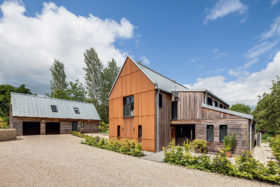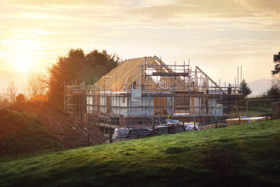
21st-22nd February 2026 - time to get your dream home started!
BOOK HERE
21st-22nd February 2026 - time to get your dream home started!
BOOK HEREIn the UK we’re lucky to have inherited an amazing stock of period properties, with almost half a million of these being listed buildings. They range from grand country houses to humble cottages.
Many are the subject of renovation or refurbishment projects and, in a number cases, listed building consent is required for any alterations that might affect their special interest.
While people are generally aware that there are limitations on what work can be done to listed buildings, what does this designation mean in practice?
During the Second World War, many important historic buildings were unfortunately lost to bombing raids, and this catalysed the creation of an official list to record those that survived. This in turn led to moves to protect these buildings for the future, and the first legislation aimed at doing so was passed in 1947.
In other areas of the country, the process has developed slightly differently – and in Scotland, Wales and Northern Ireland, conserving these assets has become the concern of the relevant national heritage bodies. While this article refers to the process in England, the principles involved are broadly the same across the UK. In England there are three categories of listing:
Grade II Buildings that are of special interest, warranting every effort be made to preserve them.
Grade II* Important properties that are of more than special interest.
Grade I Buildings that are considered to be of exceptional interest.
Selection is based on architectural or historic value. Only 2% of all listed buildings are considered unique enough to qualify as Grade I, and about half of these are places of worship. The majority of listed properties (92%) are categorised as Grade II, so chances are this will be the status relevant to most people.
The primary qualifying factor for listing is age, with all structures dating from before 1700 – that contain a significant proportion of their original fabric – being listed, as well as most of those built between 1700 and 1840.
After this date the process becomes more selective depending on individual merit, while properties under 30 years old are only listed in exceptional circumstances, such as where they represent a superior example of an architectural style.
Before embarking on any work to a property that may be listed, it is essential to establish its status. It is not safe to rely on estate agents’ particulars or on the previous owner’s account of the situation – lack of knowledge is no defence if unauthorised works are carried out.
The good news is that checking whether a property is listed is relatively straightforward. Local authorities have a database of listed buildings in their area, while Historic England maintains The National Heritage List for England. The equivalent register for Scotland is held by Historic Scotland, for Wales by CADW and Northern Ireland by its Department of the Environment.
You’ll need to obtain listed building consent for any alterations that have the potential to affect a property’s special architectural or historic interest (often referred to as its ‘significance’). This doesn’t mean that you can’t make changes, but rather the intention is to enable alterations while protecting what is particularly interesting about the building. In fact, for Grade II listings, there is now a presumption in favour of appropriate alteration and adaptation.
The consent process is managed by the local authority, invariably with the involvement of the conservation officer. This is separate from the planning process. So some projects will require both listed building and planning approval, while some only need one or the other. The good news is that there is no fee for a listed building consent application.
Due to each building’s individuality, it is not possible to give a definitive indication of what work will require consent, as the same degree of alteration may have no effect on the significance of one building but a considerable impact on another. Because of this it is always advisable to consult the conservation officer at an early stage to find out both whether work will require consent and whether it is likely to be granted.
Breaching the rules protecting listed buildings can have serious consequences. Local authorities are granted extensive powers ranging from enforcement action (eg requiring reinstatement of lost or damaged features or fabric) to resorting to legal measures that can result in large fines or even imprisonment. It is worth noting that these matters are covered by criminal rather than planning law.
Every listed building has a description in the statutory register. It is often assumed that this identifies the important elements of the building and so tells you what is protected. However, this is not the case; rather this description is only for the identification of the building.
Once listed, every element is subject to the same degree of protection, and this applies just as much internally as it does externally. Furthermore, everything fixed to the building is protected – as is any structure built before 1948 that is within the curtilage of the property at the date of listing. Curtilage can be quite difficult to define but for most purposes it can be thought of as the building plot.
Because of this situation, past alterations to the property are protected in just the same way as the original fabric and features, even if they are not as sympathetic as you might wish them to be. Alterations tell us a lot about the history and development of buildings and how they were used or lived in by former occupants. Hence they can sometimes be just as important in helping to understand social and architectural history as the original structure.
What’s more, the setting of a heritage asset is also protected within the planning process. So the effect of any proposed development in the vicinity of a listed building on its setting is a material consideration when deciding on the planning application for that development.
Some authorities maintain a local register of important or significant buildings, separate from the statutory list. There is often confusion between these and officially graded buildings. However, while there is no legal safeguard for these properties, they often have a layer of protection that comes through in local planning policy. Sometimes the purpose of this style of listing is just to bring the owner’s attention to their unique character in the hope they will respect this in making any alterations.
Photo (top): The Crossleys put their heart and soul into converting an old Sussex blacksmith’s workshop into a unique and characterful home


Comments are closed.